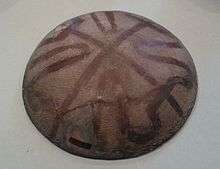C-Group culture
 Bowl of the C-Group, Musée du Louvre | |
| Regions with significant populations | |
|---|---|
| Nubia | |
| Languages | |
| Afroasiatic languages (Berber) | |
| Related ethnic groups | |
| A-Group, B-Group |
The C-Group culture was an ancient civilization centered in Nubia, which existed from ca. 2400 BCE to ca. 1550 BCE.[1] It was named by George A. Reisner. With no central site and no written evidence about what these people called themselves, Reisner assigned the culture a letter. The C-Group arose after Reisner's A-Group and B-Group cultures, and around the time the Old Kingdom was ending in Ancient Egypt.
Overview
While today many scholars see A and B as actually being a continuation of the same group, C-Group is more distinct. The C-Group is marked by its distinctive pottery, and for its tombs. Early C-Group tombs consisted of a simple "stone circle" with the body buried in a depression in the centre. The tombs later became more elaborate with the bodies being placed in a stone lined chamber, and then the addition of an extra chamber on the east: for offerings.
The origins of the C-Group are still uncertain. Some scholars see it largely being evolved from the A/B-Group. Others think it more likely that the C-Group was brought by invaders or migrants that mingled with the local culture, with the C-Group perhaps originating in the then rapidly drying Sahara.
The C-Group were farmers and semi-nomadic herders keeping large numbers of cattle in an area that is today too arid for such herding. Originally they were believed to be a peaceful people due to the lack of weapons in tombs. Their settling around the forts built by the ancient Egyptians was seen as further evidence. Today some scholars argue the lack of weapons in tombs may have been cultural and that the forts might have been constructed by the Egyptians to control the C-Group peoples.
Most of what is known about the C-Group peoples comes from Lower Nubia, due to the extensive archaeological work conducted in that region. The northern border of the C-Group was around Kubaniek. The southern border is still uncertain, but C-Group sites have been found as far south as Eritrea.
During the Egyptian Sixth Dynasty, Lower Nubia is described of consisting of a number of small states, three of which are named: Setju, Wawat, and Irjet. At this same time in Upper Nubia the Kingdom of Kerma was emerging. The exact relation between the C-Group and Kerma are uncertain, but early Kerma shows definite similarities to the C-Group culture.
Under the Middle Kingdom much of the C-Group lands in Lower Nubia were conquered by Egypt; after the Egyptians left, Kerma expanded north controlling the region. With the conquest of Nubia by Egypt under Tuthmosis I in the late 16th century BCE, the C-Group disappears, merged, along with Kerma, into the Egyptianized Kush.
Dental trait analysis of C-Group fossils found that they were closely related to other Afroasiatic-speaking populations inhabiting Northeast Africa and the Maghreb. Among the ancient populations, the C-Group people were nearest to the ancient Egyptians (Naqada, Badari, Hierakonpolis, Abydos and Kharga in Upper Egypt; Hawara in Lower Egypt) and Pharaonic era skeletons excavated in Lower Nubia, followed by the A-Group culture bearers of Lower Nubia, the Kerma and Kush populations in Upper Nubia, the Meroitic, X-Group and Christian period inhabitants of Lower Nubia, and the Kellis population in the Dakhla Oasis. Among the recent groups, the C-Group makers were morphologically closest to the Shawia and Kabyle Berber populations of Algeria as well as Bedouin groups in Morocco, Libya and Tunisia, followed by other Afroasiatic-speaking populations in the Horn of Africa. The C-Group skeletons and these ancient and recent fossils were also phenotypically distinct from those belonging to recent Negroid populations in Sub-Saharan Africa.[2]
Language
According to Peter Behrens (1981) and Marianne Bechaus-Gerst (2000), linguistic evidence indicates that the C-Group peoples spoke Afro-Asiatic languages of the Berber branch.[3][4] The Nilo-Saharan Nobiin language today contains a number of key pastoralism related loanwords that are of Berber origin, including the terms for sheep and water (e.g., Nile). This in turn suggests that the C-Group population — which, along with the Kerma Culture, inhabited the Nile Valley immediately before the arrival of the first Nubian speakers — spoke Afro-Asiatic languages.[3]
Notes
- ↑ "Ancient Nubia: C-Group–Pan Grave–Kerma 2400–1550 BC". The Oriental Institute. Retrieved 1 July 2016.
- ↑ Haddow, Scott Donald. "Dental Morphological Analysis of Roman Era Burials from the Dakhleh Oasis, Egypt" (PDF). Institute of Archaeology, University College London. Retrieved 2 June 2017.
- 1 2 Marianne Bechaus-Gerst, Roger Blench, Kevin MacDonald (ed.) (2014). The Origins and Development of African Livestock: Archaeology, Genetics, Linguistics and Ethnography - "Linguistic evidence for the prehistory of livestock in Sudan" (2000). Routledge. p. 453. ISBN 1135434166. Retrieved 15 September 2014.
- ↑ Behrens, Peter (1986). Libya Antiqua: Report and Papers of the Symposium Organized by Unesco in Paris, 16 to 18 January 1984 - "Language and migrations of the early Saharan cattle herders: the formation of the Berber branch". Unesco. p. 30. ISBN 9231023764. Retrieved 14 September 2014.
References
- Oliver, Roland (1978). The Cambridge history of Africa. Vol. 2, From c. 500 BC to AD 1050. Cambridge: Cambridge University Press. pp. 858 Pages. ISBN 0-521-21592-7.